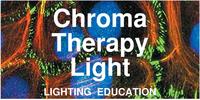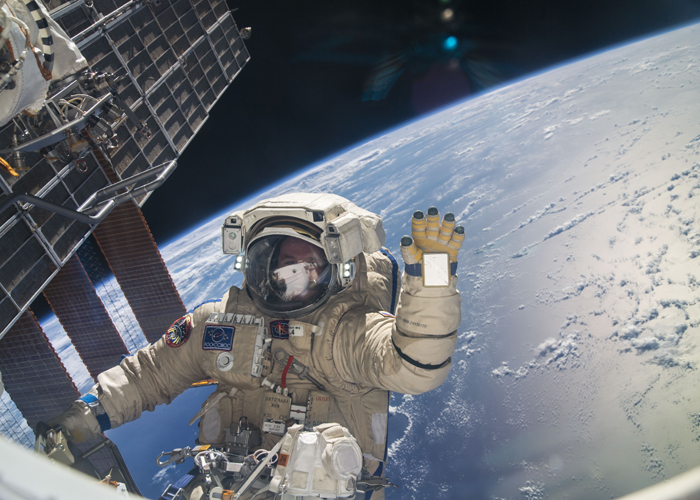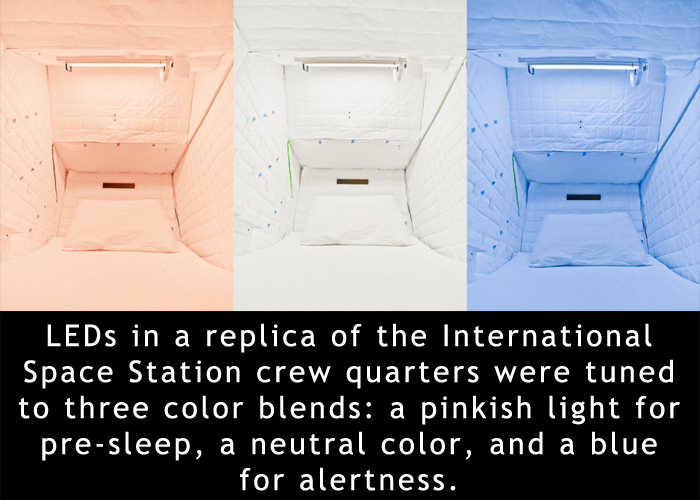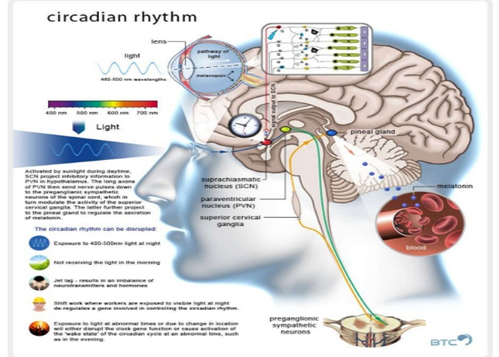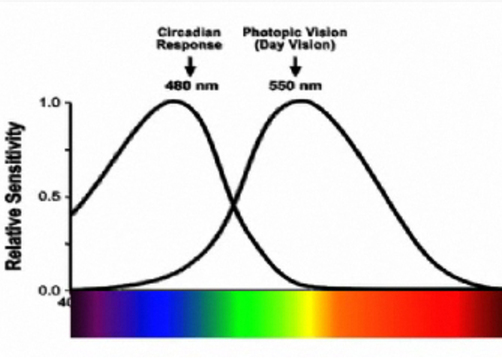|
NASA - Lighting in Outer Space - Learning Objectives
Adjusting lighting for healthy Circadian System
Russian cosmonaut Sergey Ryazanskiy, Expedition 37 flight engineer, attired in a Russian Orlan spacesuit, is pictured during a session of extravehicular activity. 2013
The Key to Better Sleep in Space? Some Nice, Colorful Light"Red-shifted light allows sleep, and bluish light wakes you up, so the next question is whether astronauts can sleep better and then perform better with wavelength-controlled illumination. By 2016, NASA plans to install the bulbs in the real crew quarters—and its astronauts can get some well-deserved shut-eye. ..." [1]
At-sea trial of 24-h-based submarine watchstanding schedules with high and low correlated color temperature light sources.
"United States Navy submariners have historically lived with circadian disruption while at sea due to 18-h-based watch schedules. Previous research demonstrated that circadian entrainment improved with 24-h-based watch schedules. Twenty-nine male crew members participated in the study, which took place on an actual submarine patrol. ... " [2] April 2015
Circadian System
The sun plays an important role in our wake and sleep cycles, know as your Circadian Rhythm. Our ancestors evolved under the natural cycles of daylight and dark nights.
In artificial environments: outer space, Arctic research centers, and undersea natural light must be simulated with electric lighting. Light is energy that influences mind and body - many chemicals in our bodies are controlled by light. Melatonin is produced at night to direct our bodies to sleep. Exposure to blue tinted light can delay sleep for as much as two hours. |
Bold Endeavors: Lessons from Polar and Space ExplorationThe recognition of our circadian system and external influences is fairly recent and much research continues today. As Jack Stuster points out in his 1996 book, Bold Endeavors: Lessons from Polar and Space Exploration, the term circadian rhythms was coined in 1959 by Franz Halberg from the Latin circa (about) and diem (a day). In 1982 scientists were discussing internal circadian rhythms and external zeitgebers (from the German for time givers).
"Almost all physiological, psychological, and behavioral parameters, including body temperature, production of serum and urinary corticosteroids and electrolytes, cardiovascular functions, muscle strength, alertness, mood, and memory, follow circadian rhythms. Although circadian rhythms are generated internal to an organism, they are regulated by external cues, primarily the cycle of light and darkness. ... If the individual is isolated without access to any time cues, however, the sleep / wake cycle and body temperature rhythms drift toward later times each day and are expressed in free-running periods of 25.4 hours; at this rate an individual's sleep /wake cycle could drift nearly 10 hours per week in the absence of diurnal cues. ... The imposition of period and phase control by environmental cues is called entrainment. ... Earth and Mars have nearly identical rotation rates (twenty-four hours and thirty-seven minutes for Mars) Earth and Mars also share a similar sequence of seasons because their polar axis are tipped almost identically." [3] Former Astronaut Jack Stuster concludes this chapter, Study Results, with eight recommendations regarding sleep during long-duration space missions: schedules, tasks, zeitgebers, sleep hygiene, sleep chambers, exits, safety, shift work, and communication devices. Circadian Brain
Brain Signals
Circadian Response Curve, blue light (480 nanometers) during the day, helps promote healthy sleep with melatonin production at night. Photopic vision, the ability to see colors, peaks in daylight (550 nanometers). Selecting lighting containing correct and varied spectral output becomes critical in artificial illuminated environments of space, Arctic, and undersea.Footnotes
Photo Credits
|
- Home
-
- CHROMA Topics
- Color Spectrum - Light is Energy
- Color in Light
- Color in Nature
- Color in Paint
- Why does paint fade?
- Color Names & Meanings
- Color Phenomena
- Color Perception is Individual
- Color In Fashion
- Color for your home
- Color in Space
- Color Blindness
- Color Blind Interview
- Synesthesia
- Synesthete Deborah Borrowdale-Cox
- Synesthete Stephen Orr, BH&G Editor
-
- Circadian & THERAPY Topics
- Circadian Explained
- Circadian Ganglion Cells
- Circadian Melatonin
- Circadian Animals
- Circadian Research
- Autism & Lighting for the Spectrum
- Blue Light Dimming Apps
- Red Night Lights
- Vitamin D & Light
- SAD - Seasonal Affective Disorder
- Alzheimers and Light Therapy
- Photosensitivity - Light Sensitive Drugs
- Red Light Therapy
- Sleep & Lighting
- Dreams and Second Sleep
- NASA - Lighting in Space & Undersea
- Jet Lag
- Sunglasses
- Chakras
- Crystals, Minerals, & Gemstones
-
- LIGHTing Design Topics
- UV Germicidal Disinfection Light
- LED Lighting Facts Card
- CRI - Color Rendering Index
- LED TM-30
- LED Kelvin Color
- LED LPW
- LED Flicker
- LED Glare
- OLED - Organic LED
- Human Centric Lighting
- Lighting with Daylighting
- Lighting for Healthy Buildings & Zero Net Energy
- Lighting for Healthcare
- Lighting for Horticulture
- Lighting for Hospitality & LED Retrofits
- Lighting for Museums
- Lighting for Seniors & Low Vision
- Lighting Design Tips & Codes
- Parking Lot Lighting
- Solar Lighting for Humanity & World Health
- Davis Insectary Garden
- Santa Barbara Mesa Insectary Garden
- Home
-
- CHROMA Topics
- Color Spectrum - Light is Energy
- Color in Light
- Color in Nature
- Color in Paint
- Why does paint fade?
- Color Names & Meanings
- Color Phenomena
- Color Perception is Individual
- Color In Fashion
- Color for your home
- Color in Space
- Color Blindness
- Color Blind Interview
- Synesthesia
- Synesthete Deborah Borrowdale-Cox
- Synesthete Stephen Orr, BH&G Editor
-
- Circadian & THERAPY Topics
- Circadian Explained
- Circadian Ganglion Cells
- Circadian Melatonin
- Circadian Animals
- Circadian Research
- Autism & Lighting for the Spectrum
- Blue Light Dimming Apps
- Red Night Lights
- Vitamin D & Light
- SAD - Seasonal Affective Disorder
- Alzheimers and Light Therapy
- Photosensitivity - Light Sensitive Drugs
- Red Light Therapy
- Sleep & Lighting
- Dreams and Second Sleep
- NASA - Lighting in Space & Undersea
- Jet Lag
- Sunglasses
- Chakras
- Crystals, Minerals, & Gemstones
-
- LIGHTing Design Topics
- UV Germicidal Disinfection Light
- LED Lighting Facts Card
- CRI - Color Rendering Index
- LED TM-30
- LED Kelvin Color
- LED LPW
- LED Flicker
- LED Glare
- OLED - Organic LED
- Human Centric Lighting
- Lighting with Daylighting
- Lighting for Healthy Buildings & Zero Net Energy
- Lighting for Healthcare
- Lighting for Horticulture
- Lighting for Hospitality & LED Retrofits
- Lighting for Museums
- Lighting for Seniors & Low Vision
- Lighting Design Tips & Codes
- Parking Lot Lighting
- Solar Lighting for Humanity & World Health
- Davis Insectary Garden
- Santa Barbara Mesa Insectary Garden
